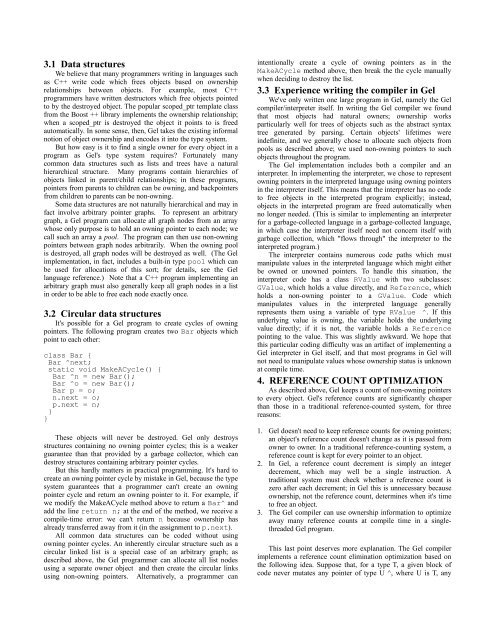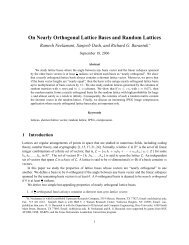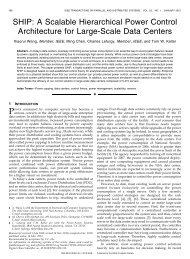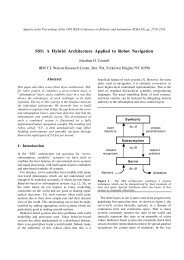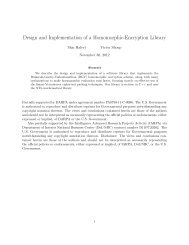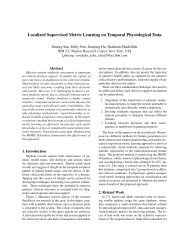Ownership You Can Count On: A Hybrid Approach - Researcher - IBM
Ownership You Can Count On: A Hybrid Approach - Researcher - IBM
Ownership You Can Count On: A Hybrid Approach - Researcher - IBM
Create successful ePaper yourself
Turn your PDF publications into a flip-book with our unique Google optimized e-Paper software.
3.1 Data structures<br />
We believe that many programmers writing in languages such<br />
as C++ write code which frees objects based on ownership<br />
relationships between objects. For example, most C++<br />
programmers have written destructors which free objects pointed<br />
to by the destroyed object. The popular scoped_ptr template class<br />
from the Boost ++ library implements the ownership relationship;<br />
when a scoped_ptr is destroyed the object it points to is freed<br />
automatically. In some sense, then, Gel takes the existing informal<br />
notion of object ownership and encodes it into the type system.<br />
But how easy is it to find a single owner for every object in a<br />
program as Gel's type system requires? Fortunately many<br />
common data structures such as lists and trees have a natural<br />
hierarchical structure. Many programs contain hierarchies of<br />
objects linked in parent/child relationships; in these programs,<br />
pointers from parents to children can be owning, and backpointers<br />
from children to parents can be non-owning.<br />
Some data structures are not naturally hierarchical and may in<br />
fact involve arbitrary pointer graphs. To represent an arbitrary<br />
graph, a Gel program can allocate all graph nodes from an array<br />
whose only purpose is to hold an owning pointer to each node; we<br />
call such an array a pool. The program can then use non-owning<br />
pointers between graph nodes arbitrarily. When the owning pool<br />
is destroyed, all graph nodes will be destroyed as well. (The Gel<br />
implementation, in fact, includes a built-in type pool which can<br />
be used for allocations of this sort; for details, see the Gel<br />
language reference.) Note that a C++ program implementing an<br />
arbitrary graph must also generally keep all graph nodes in a list<br />
in order to be able to free each node exactly once.<br />
3.2 Circular data structures<br />
It's possible for a Gel program to create cycles of owning<br />
pointers. The following program creates two Bar objects which<br />
point to each other:<br />
class Bar {<br />
Bar ^next;<br />
static void MakeACycle() {<br />
Bar ^n = new Bar();<br />
Bar ^o = new Bar();<br />
Bar p = o;<br />
n.next = o;<br />
p.next = n;<br />
}<br />
}<br />
These objects will never be destroyed. Gel only destroys<br />
structures containing no owning pointer cycles; this is a weaker<br />
guarantee than that provided by a garbage collector, which can<br />
destroy structures containing arbitrary pointer cycles.<br />
But this hardly matters in practical programming. It's hard to<br />
create an owning pointer cycle by mistake in Gel, because the type<br />
system guarantees that a programmer can't create an owning<br />
pointer cycle and return an owning pointer to it. For example, if<br />
we modify the MakeACycle method above to return a Bar^ and<br />
add the line return n; at the end of the method, we receive a<br />
compile-time error: we can't return n because ownership has<br />
already transferred away from it (in the assignment to p.next).<br />
All common data structures can be coded without using<br />
owning pointer cycles. An inherently circular structure such as a<br />
circular linked list is a special case of an arbitrary graph; as<br />
described above, the Gel programmer can allocate all list nodes<br />
using a separate owner object and then create the circular links<br />
using non-owning pointers. Alternatively, a programmer can<br />
intentionally create a cycle of owning pointers as in the<br />
MakeACycle method above, then break the the cycle manually<br />
when deciding to destroy the list.<br />
3.3 Experience writing the compiler in Gel<br />
We've only written one large program in Gel, namely the Gel<br />
compiler/interpreter itself. In writing the Gel compiler we found<br />
that most objects had natural owners; ownership works<br />
particularly well for trees of objects such as the abstract syntax<br />
tree generated by parsing. Certain objects' lifetimes were<br />
indefinite, and we generally chose to allocate such objects from<br />
pools as described above; we used non-owning pointers to such<br />
objects throughout the program.<br />
The Gel implementation includes both a compiler and an<br />
interpreter. In implementing the interpreter, we chose to represent<br />
owning pointers in the interpreted language using owning pointers<br />
in the interpreter itself. This means that the interpreter has no code<br />
to free objects in the interpreted program explicitly; instead,<br />
objects in the interpreted program are freed automatically when<br />
no longer needed. (This is similar to implementing an interpreter<br />
for a garbage-collected language in a garbage-collected language,<br />
in which case the interpreter itself need not concern itself with<br />
garbage collection, which "flows through" the interpreter to the<br />
interpreted program.)<br />
The interpreter contains numerous code paths which must<br />
manipulate values in the interpreted language which might either<br />
be owned or unowned pointers. To handle this situation, the<br />
interpreter code has a class RValue with two subclasses:<br />
GValue, which holds a value directly, and Reference, which<br />
holds a non-owning pointer to a GValue. Code which<br />
manipulates values in the interpreted language generally<br />
represents them using a variable of type RValue ^. If this<br />
underlying value is owning, the variable holds the underlying<br />
value directly; if it is not, the variable holds a Reference<br />
pointing to the value. This was slightly awkward. We hope that<br />
this particular coding difficulty was an artifact of implementing a<br />
Gel interpreter in Gel itself, and that most programs in Gel will<br />
not need to manipulate values whose ownership status is unknown<br />
at compile time.<br />
4. REFERENCE COUNT OPTIMIZATION<br />
As described above, Gel keeps a count of non-owning pointers<br />
to every object. Gel's reference counts are significantly cheaper<br />
than those in a traditional reference-counted system, for three<br />
reasons:<br />
1. Gel doesn't need to keep reference counts for owning pointers;<br />
an object's reference count doesn't change as it is passed from<br />
owner to owner. In a traditional reference-counting system, a<br />
reference count is kept for every pointer to an object.<br />
2. In Gel, a reference count decrement is simply an integer<br />
decrement, which may well be a single instruction. A<br />
traditional system must check whether a reference count is<br />
zero after each decrement; in Gel this is unnecessary because<br />
ownership, not the reference count, determines when it's time<br />
to free an object.<br />
3. The Gel compiler can use ownership information to optimize<br />
away many reference counts at compile time in a singlethreaded<br />
Gel program.<br />
This last point deserves more explanation. The Gel compiler<br />
implements a reference count elimination optimization based on<br />
the following idea. Suppose that, for a type T, a given block of<br />
code never mutates any pointer of type U ^, where U is T, any


